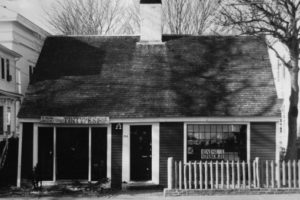Ken Fulk speaks of his loving restoration of the Vorse House in Provincetown — a house, he says, that “we couldn’t afford to lose.” I write of one that was lost.
When my husband, Kurt, and I bought the house at 244 Commercial St., in 1958, it was still a remarkably intact 18th-century building. We always spoke of it as the Pfeiffer house, after its previous owner, the artist Heinrich Pfeiffer, but it should more properly have been called the Chapman house, for Samuel Chapman, the earliest owner I could trace.
Samuel’s life offers a revealing view of Provincetown history.

He was born in Pennsylvania, but joined and then accepted a commission in the British Army in 1776. In 1780, he was captured aboard a privateer and taken to Massachusetts. There, having been attainted of high treason in Pennsylvania, and found “particularly obnoxious as an officer of a corps employed to harass the inhabitants in stealing horses and similar offenses,” it was requested he not be exchanged in the ordinary way, but kept in custody. The ship must have been taken near our shores, though I have not yet been able to verify how it was that he was held in Truro. He was tried in 1781, and much to the disappointment of many, acquitted.
Samuel Chapman’s custody in Truro did not prevent him from marrying Elizabeth Lombard, a local girl. As many Tory sympathizers did, the two left for Chester, Cape Breton, Nova Scotia, where a son, Abraham, was born in 1790. The family returned to the Cape the following year, where another two sons and a daughter were born. In an ironic tit for tat, young Abraham, having adopted his generation’s American allegiances, was captured during the War of 1812 and taken to Dartmoor Prison in England.
Cape Codders have long memories. We run into Abraham Chapman again in Nancy Paine Smith’s The Provincetown Book (1922), where he is part of an 1838 town meeting debate on a proposal to build a sidewalk.
“When it was apparent how close the vote would be, someone challenged Mr. Abraham Chapman (a sidewalk man) as not an American citizen. Full of indignation, Mr. Chapman demanded an explanation and was told that his folks were Tories during the Revolutionary War, that they had gone from Town to Nova Scotia, where he was born; that he was 6 months old when he came to the U.S., and not entitled to vote. But his vote was admitted.”
And the first plank sidewalk was built.
One hundred twenty years later, we bought the Chapman house from Heinrich Pfeiffer’s widow. To restore the original footprint, we removed a small building adjacent to the main house, discovering in the process its construction date, June 16, 1866, on a board of the west wall under the clapboard siding. In 1916 it had been assessed to Mary E. Crowell as a store and dwelling. And later, Mr. Pfeiffer had used it as a studio and shop selling his etchings of local scenes.
For nearly 200 years, little had been done to update the main house. Still in place were the nine-over-six original windows, the original fireplaces and mantles, all the interior doors and cupboards with H hinges, a “snug harbor” (a small enclosed space adjacent to the chimney for drying wet boots or clothing), a steep staircase to the two rooms on the upper floor, the pine flooring, and pine paneling that included one single board measuring 28 inches wide. We retained all these features, though we did replace the individual windows on the front of the house with larger ones more suitable for our shop.
There we ran the Old Village Store, our version of a country store, until 1967.
When we decided to sell the property, we vowed to sell it only to someone who would respect and maintain the building. We thought we had found that buyer, a family that included an artist and an architect. But right away the house was divided into two shops. Shortly afterwards, the building was raised and two more shops appeared beneath it. I have no idea of what, if anything, remains of the original interior.
The late Josephine Del Deo commented on the house in a note to David Dunlap, for his book Building Provincetown: “This iconic landmark of Provincetown… was the key that turned the lock and opened my awareness to the danger of development uncontrolled….”
So 244 Commercial St. is lost and, sadly, there is no way to bring it back.
Irma Ruckstuhl is the author of Old Provincetown in Early Photographs and A Lady Buys. She lives in North Truro.



